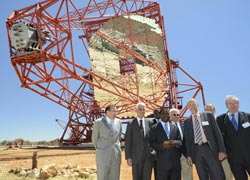Inauguration ceremony of the H.E.S.S. II Telescope

(from left) Eberhard Bodenschatz, Werner Hofmann, Nithaya Chetty, Abraham Iyambo, Jean-Louis Zoël, André Scholz und Jaques Martino (rightmost) in front of the H.E.S.S. II telescope.<br><br>Foto: C. Föhr, H.E.S.S. Collaboration<br>
Werner Hofmann (MPI for Nuclear Physics, Heidelberg), spokesperson of the H.E.S.S. collaboration opened the ceremony with a brief presentation on H.E.S.S. II followed by a series of messages by Lazarus Hangula (Vice Chancellor of the University of Namibia), Eberhard Bodenschatz (Deputy Chair of the CPT Section of the Max Planck Society), Jaques Martino (Director of CNRS/IN2P3), Daniel Weselka (Federal Ministry of Science and Research, Austria), Nithaya Chetty (Head of astronomy at the NRF, South Africa), Jean-Louis Zoël (Ambassador of the French Republic) and André Scholz (Chargé d’Affairs of the German Embassy).
Eberhard Bodenschatz conveyed a message from Peter Gruss, President of the Max Planck Society, which contributed about 50% of the resources of the H.E.S.S. II project. Daniel Weselka commemorated the discovery of cosmic rays by Victor Hess 100 ago after whom the observatory is named. All speakers complimented the international collaboration and the contributions from science, technology and various institutions without them such a project would not have been possible.
The keynote speech was given by Abraham Iyambo, Minister for Education of the Republic of Namibia, on behalf of the President of Namibia, Hifikepunye Pohamba. He emphasised the previous pioneering discoveries of the H.E.S.S. Cherenkov telescope array and its international recognition among world’s top ten observatories. H.E.S.S. put Namibia on the science map of the world and this success story will be continued with H.E.S.S. II. Addressing future junior scientists the minister encouraged school students to visit the H.E.S.S. site.
At the end of the ceremony, Abraham Iyambo pressed the ‘red button’ to activate the new telecope. The guests were deeply impressed by the synchronised motion of the five telecopes and how rapid the 580 tonnes heavy H.E.S.S. II telescope can point to any position in the sky. During the tour around the H.E.S.S. site the also the automatic assembly of the 3 tonnes heavy camera was demonstrated.
The sequence of inauguration events started the day before with an international symposium and concluded with an Open Day for the general public at the H.E.S.S. site on Sunday 30 September 2012.
Contact:
Prof. Dr. Werner Hofmann (Spokesperson of the H.E.S.S. Collaboration)
Tel.: +49 6221 516 330
E-Mail: werner.hofmann (at) mpi-hd.mpg.de
Dr. Michael Panter
Tel.:+49 6221 516 273
E-Mail: michael.panter (at) mpi-hd.mpg.de
Media Contact
More Information:
http://www.mpi-hd.mpg.de/hfm/HESS/All latest news from the category: Physics and Astronomy
This area deals with the fundamental laws and building blocks of nature and how they interact, the properties and the behavior of matter, and research into space and time and their structures.
innovations-report provides in-depth reports and articles on subjects such as astrophysics, laser technologies, nuclear, quantum, particle and solid-state physics, nanotechnologies, planetary research and findings (Mars, Venus) and developments related to the Hubble Telescope.
Newest articles

Innovative 3D printed scaffolds offer new hope for bone healing
Researchers at the Institute for Bioengineering of Catalonia have developed novel 3D printed PLA-CaP scaffolds that promote blood vessel formation, ensuring better healing and regeneration of bone tissue. Bone is…

The surprising role of gut infection in Alzheimer’s disease
ASU- and Banner Alzheimer’s Institute-led study implicates link between a common virus and the disease, which travels from the gut to the brain and may be a target for antiviral…

Molecular gardening: New enzymes discovered for protein modification pruning
How deubiquitinases USP53 and USP54 cleave long polyubiquitin chains and how the former is linked to liver disease in children. Deubiquitinases (DUBs) are enzymes used by cells to trim protein…


